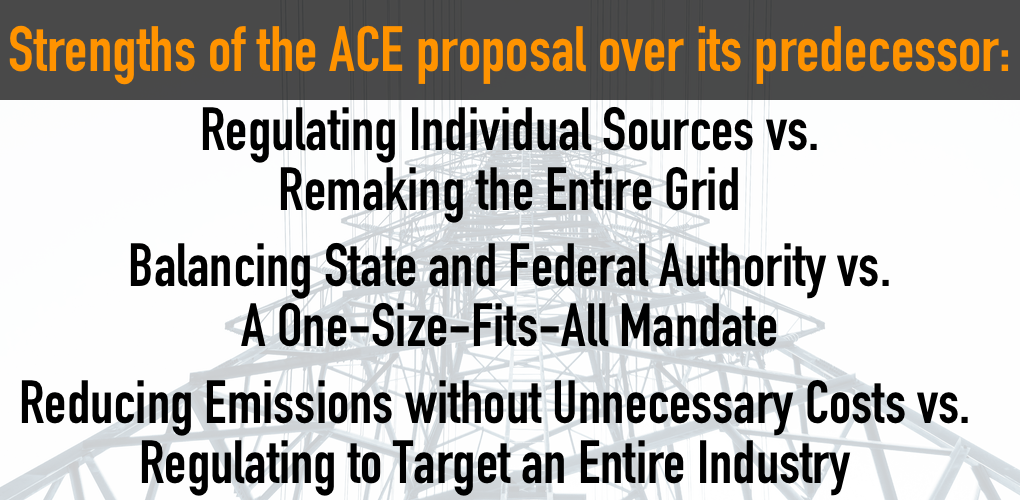
A Legal Approach to Emissions Reduction, An Eye Towards a Global Challenge
The EPA rolled out the final version of its long-anticipated Affordable Clean Energy (ACE) rule this morning. The rule is the replacement for the so-called Clean Power Plan (CPP), which the previous administration claimed as its crowning environmental achievement. Quite an achievement it was. Along with never being implemented due to an unprecedented stay from the U.S. Supreme Court, the CPP offered little in the way of environmental gain but much in the way of costs.
The ACE rule, on the other hand, trades the CPP’s enormous price tag for hundreds of millions of dollars in benefits. It also puts states back in the driver’s seat to build emissions-reductions strategies that work for their unique circumstances and electricity mixes.
The prior administration tried to camouflage the true intentions of the CPP but at its core it was little more than a plan designed to dismantle the nation’s coal industry. While consumers across the country would have felt the pain of surging electricity prices, the heaviest burden would have fallen on coal states and coal communities. It’s a night and day comparison between the regulatory overreach and burden of the CPP and the measured, legally-sound ACE rule now taking its place.
Hal Quinn, NMA president and CEO said today, “In this rule, the EPA has accomplished what eluded the prior administration: providing a clear, legal pathway to reduce emissions while preserving states’ authority over their own grids.”
Instead of dismantling the nation’s coal fleet, the ACE rule respects the regulatory limits of the Clean Air Act and offers a path forward to improve the efficiency of existing, essential plants that provide the foundation for the nation’s affordable, reliable and secure supply of electricity.
EPA Administrator Andrew Wheeler said of the rule, and the approach his agency took in crafting it, “rather than Washington telling Americans what type of energy they can use, or how they can travel, or even what they can eat, we are working cooperatively with the states to provide affordable, dependable and diverse supply of energy that continues to get cleaner and more efficient.”
Global Context
While critics of the new rule are hardly in short supply, BP’s recently released Statistical Review of World Energy helps bring some needed perspective to this conversation. While climate hawks would like to bury the U.S. coal industry and the hundreds of thousands of jobs it supports tomorrow, (here’s looking at you Mayor Bloomberg) global coal use is growing. The U.S. coal industry is but one piece in a far larger story.
In 2018, global coal consumption grew by 1.4%, double its 10-year average growth, with India and China pacing the increase in consumption. The Asian Pacific region now accounts for three quarters of global coal consumption. China, alone, consumes more coal than the rest of the world combined. While China continues to lead the world in the deployment of renewable energy, its coal production and coal consumption are growing as well. In fact, according to recent analysis, China’s fleet of coal plants has expanded by nearly 40% since 2014. And despite this surge in capacity, the fleet’s utilization grew last year as well. The average age of a coal plant in Asia is just 11 years. Asia’s coal fleet – which is seeing new additions every month – has decades of production ahead of it.
Despite the flawed thinking of activists, reducing global emissions is hardly as simple as closing U.S. coal plants or stopping new U.S. oil and natural gas pipelines. Heavy-handed regulatory policies that trade affordable, existing sources of power for more expensive, less reliable alternatives are not the right path forward either. Consumers are clear, they want environmental progress, but they don’t want it to come with higher energy prices and economy-killing regulation.
The need for innovation as well as research and development in the energy space is far more than a throwaway line dismissed by the renewable-or-nothing crowd. Reducing emissions both here and abroad and meeting the world’s energy needs is going to take new and better technologies. Recall that Fatih Birol, director of the International Energy Agency, believes carbon capture is the “most vital” technology to meeting global emissions targets.
Effective emissions strategies must be replicable. Technology solutions that help reduce emissions from the fuels the world uses and will continue to use, are essential. The costly, regressive Clean Power Plan, and top-down policies like it, are just the opposite. The U.S needs an approach to environmental progress that benefits Americans, instead of inflicting harm. The ACE rule puts us back on the right path.
- On June 19, 2019
